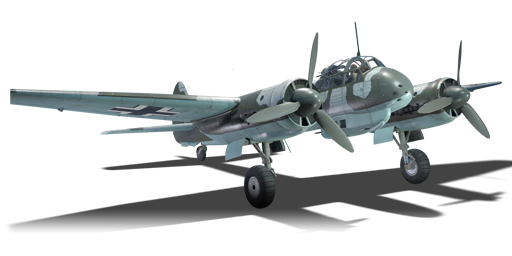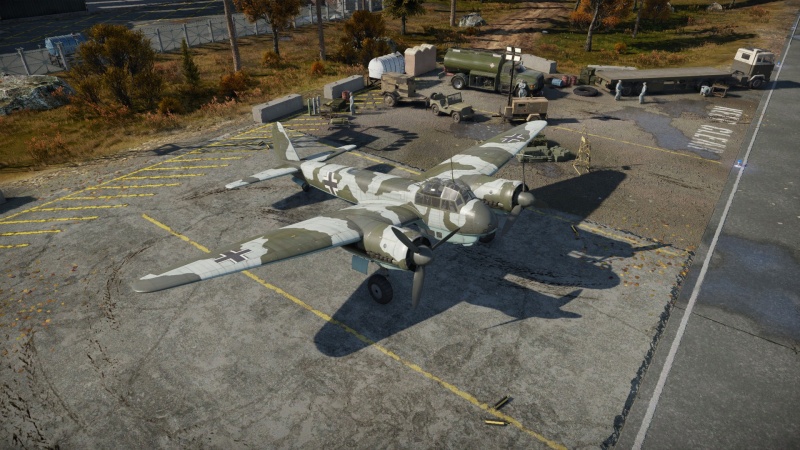Ju 88 C-6
| This page is about the German twin-engine fighter Ju 88 C-6. For other versions, see Ju 88 (Family). |
Contents
Description
The Ju 88 C-6 is a rank II German twin-engine fighter with a battle rating of 2.7 (AB/SB) and 2.3 (RB). It was introduced in Update 1.65 "Way of the Samurai".
General info
Flight performance
| Characteristics | Max Speed (km/h at 5,600 m) |
Max altitude (metres) |
Turn time (seconds) |
Rate of climb (metres/second) |
Take-off run (metres) | |||
|---|---|---|---|---|---|---|---|---|
| AB | RB | AB | RB | AB | RB | |||
| Stock | 468 | 450 | 9800 | 30.5 | 31.9 | 5.0 | 5.0 | 730 |
| Upgraded | 514 | 490 | 27.6 | 29.0 | 10.9 | 7.6 | ||
Details
| Features | ||||
|---|---|---|---|---|
| Combat flaps | Take-off flaps | Landing flaps | Air brakes | Arrestor gear |
| ✓ | ✓ | ✓ | X | X |
| Limits | ||||||
|---|---|---|---|---|---|---|
| Wings (km/h) | Gear (km/h) | Flaps (km/h) | Max Static G | |||
| Combat | Take-off | Landing | + | - | ||
| 675 | 310 | 457 | 428 | 280 | ~12 | ~7 |
| Optimal velocities (km/h) | |||
|---|---|---|---|
| Ailerons | Rudder | Elevators | Radiator |
| < 350 | < 360 | < 370 | > 331 |
Survivability and armour
- 12 mm steel - nose bulkhead in front of cockpit
- 12 mm steel - below / behind belly gunner
- 12 mm steel - pilot's seat
- 20 mm steel - bulkhead behind cockpit
- 60 mm bulletproof glass - armoured windscreen
- 58 mm bulletproof glass - cockpit sides
- 60 mm bulletproof glass - top gunner
- Self-sealing fuel tanks (4 in each wing)
Modifications and economy
Armaments
Offensive armament
The Ju 88 C-6 is armed with:
- 1 x 20 mm MG FF/M cannon, nose-mounted (120 rpg)
- 2 x 20 mm MG FF/M cannons, chin-mounted (120 rpg = 240 total)
- 3 x 7.92 mm MG 17 machine guns, nose-mounted (1,000 rpg top/left + 800 rpg right = 2,800 total)
Suspended armament
The Ju 88 C-6 can be outfitted with the following ordnance:
- Without load
- 10 x 50 kg SC50JA bombs (500 kg total)
Defensive armament
The Ju 88 C-6 is defended by:
- 2 x 7.92 mm MG 81 machine guns, dorsal turret (1,000 rpg = 2,000 total)
- 2 x 7.92 mm MG 81 machine guns, ventral turret (1,800 + 900 = 2,700 total)
Usage in battles
Bombers are often the main target for Ju 88 pilots. They can be easily caught and disposed of with the powerful cannons. Luckily, many bombers at this BR have only light machine guns as defensive armament, making them easy targets and not particularly threatening. However, there are some exceptions.
Beaufort Mk VIII - The Beaufort is fast and has a powerful twin .50 cal turret at the back. This can engage you at long range and cause serious damage to your aircraft. Try to approach it from underneath or in a head on, a blind spot for the defensive .50 cal turret.
B-34 - Same as the Beaufort, it has a powerful turret with twin .50 cals. Approaching from behind is very dangerous. This aircraft also has good offensive armament, so approaching from the front is dangerous too. The best option is to hit it from underneath.
Manual Engine Control
| MEC elements | ||||||
|---|---|---|---|---|---|---|
| Mixer | Pitch | Radiator | Supercharger | Turbocharger | ||
| Oil | Water | Type | ||||
| Not controllable | Controllable Auto control available |
Controllable Not auto controlled |
Controllable Not auto controlled |
Separate | Not controllable 1 gear |
Not controllable |
Pros and cons
Pros:
- 3 x 20 mm MG FF/M cannons with Minengeschoß rounds that will make short work of any air target
- All offensive armament is centre-mounted, making them extremely deadly
- Decent defensive armament of 7.92 mm with good coverage
- Internal bomb bay, meaning the bombload affects weight, but not drag
- Good climb rate
- Durable airframe
- Manoeuvrable for a heavy fighter/bomber
- Ability to perform multiple roles such as a bomber, ground attacker, and heavy fighter
- Gets the attacker spawn in AB
Cons:
- Guns are sighted to aim below the nose tip of the plane, making it very awkward to aim in a dogfight
- Single-seat fighters are much more manoeuvrable
- Slow plane that presents itself as a large target
- Cannons fire with sluggish muzzle velocity and rate of fire
- Relatively low wing rip speed somewhat limits effectiveness at diving
- Engines are easily damaged, and the Ju 88 C-6 has a hard time flying with just one engine
- Prone to fires
- Locks up in dives, making it hard to pull out when getting near wing rip speed
- Although it can perform different roles, it excels at none of them
- No airbrakes, unlike the bomber variants of Ju 88 series
History
JU88 is the most important forces during the second world war the German air force, well done to include tactical, anti-ship, remote surveillance, water and even the night air, a series of tasks, with excellent performance and is almost omnipotent domestic for itself as an icon of the concept of "blitz"; However, heavy losses in the air battle of Britain left most people with the impression that the JU88 was extremely vulnerable in day air combat, unable to escape fighter protection. After the official production of the JU88, the Luftwaffe, which was still fascinated with the destroyer, immediately thought of the possibility of developing it into a day fighter. With this idea, several ju88Cs with specially enhanced forward fire were produced for demonstration. On 21 February 1940 KG30 received a batch of JU88C2s to form an additional expulsion squadron. Although not part of the western Front campaign, the opportunity for demonstration came soon after. On April 12, Britain launched its largest bombing campaign since the war and failed miserably. The intercepting JU88C2 shot down two bombers but one of its own was shot down by defensive fire. The squadron then moved on to participate in the Norwegian campaign, making limited ground attacks simultaneously escorting JU88A and JU52. By the end of the campaign, the squadron claimed seven more air victories and only one of its own was forced to land seriously injured by anti-aircraft fire.
In the report submitted to RLM, the performance and role of JU88C was fully affirmed, the squadron leader pointed out that its excellent handling, long range and the ability to attack under bad weather conditions can be fully qualified for the role of the expulsion aircraft positioning, enough to pose a serious threat to enemy bombers, recommended formal production and large-scale use. However, in response to the opening of British night bombing, the squadron was reorganized into a night fighting unit. Later, the BF110 fiasco in British skies and the ME210 failure turned the day fighter from darling to abandoned, and the Luftwaffe was unwilling to develop any new day fighter. At the same time, a large number of JU88s were rolled off the production line as bombers and sent to the front lines to be consumed. Now the various battlefields were in urgent need of these efficient bombers, while the small number of JU88C were all received by the night fighting units. The idea of using the JU88 as a heavy day fighter was shelved indefinitely.
After a long wait, the opportunity finally came. Although the British in the ballista action hit the French navy avoid she went down to Germany, war or from the French navy got what they want - a long coastline and a large number of fine port, the u-boats wolves can now broken engagement from France in the west bank, they will be more deadly than predecessors in the last war. In the first two years of the war, the Air Force used the FW200 to support U-boat operations, but as the intensity of the war increased, the FW200's firepower and maneuverability became inadequate, and the RANGE of the BF110 and FW190 was not sufficient for deep ocean operations. Is there an aircraft that could operate without disrupting the production schedule? Meet the needs of fierce firepower, all-weather operations and long range at the same time?
After a series of complicated and dazzling preparation and reorganization, the fifth KG40 Group using JU88C6 was formally established in July 1942. Compared with the previous JU88C2, the C6 had improved speed and mobility by replacing the engine. Meanwhile, forward fire and self-defense fire were further improved. Perfect for hunting allied anti-submarine aircraft and bombers deep in the ocean.
Media
- Skins
- Videos
See also
Links to the articles on the War Thunder Wiki that you think will be useful for the reader, for example:
- reference to the series of the aircraft;
- links to approximate analogues of other nations and research trees.
External links
| Junkers Aircraft and Motor Works (Junkers Flugzeug- und Motorenwerke Aktiengesellschaft) | |
|---|---|
| Fighters | Ju 88 C-6 · Ju 388 J |
| Strike Aircraft | |
| Ju 87 | Ju 87 G-1 · Ju 87 G-2 |
| Bombers | Ju 88 A-1 · Ju 88 A-4 · Ju 188 A-2 · Ju 288 C |
| Ju 87 | Ju 87 B-2 · Ju 87 D-3 · Ju 87 D-5 · Ju 87 R-2 · Ju 87 R-2 Libya |
| Export | ▄Ju 87 D-3 · ▄Ju 87 R-2 · ▄Ju 88 A-4 |
| Germany twin-engine fighters | |
|---|---|
| Messerschmitt | Bf 109 Z-1 |
| Me 410 A-1/U2 · Me 410 B-1/U2 | |
| Dornier | Do 17 Z-7 · Do 217 J-1 · Do 217 J-2 · Do 217 N-1 · Do 217 N-2 |
| Focke-Wulf | Ta 154 A-1 |
| Junkers | Ju 88 C-6 · Ju 388 J |





